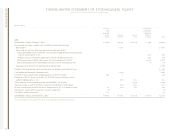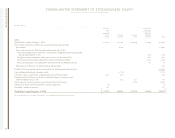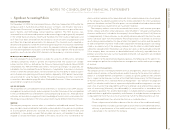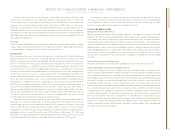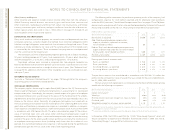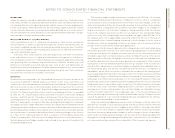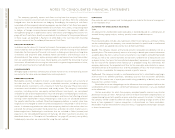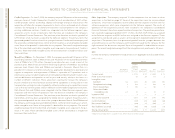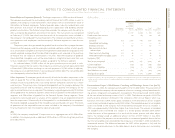IBM 2004 Annual Report Download - page 53
Download and view the complete annual report
Please find page 53 of the 2004 IBM annual report below. You can navigate through the pages in the report by either clicking on the pages listed below, or by using the keyword search tool below to find specific information within the annual report.
NOTES TO CONSOLIDATED FINANCIAL STATEMENTS
51
International Business Machines Corporation and Subsidiary Companies
ibm annual report 2004
If these criteria are not met, the revenue is deferred until the earlier of when such
criteria are met or when the last undelivered element is delivered. If there is VSOE for all
units of accounting in an arrangement, the arrangement consideration is allocated to the
separate units of accounting based on each unit’s relative VSOE. There may be cases,
however, in which there is VSOE of the undelivered item(s) but no such evidence for the
delivered item(s). In these cases, the residual method is used to allocate the arrangement
consideration. Under the residual method, the amount of consideration allocated to the
delivered item(s) equals the total arrangement consideration less the aggregate VSOE of
the undelivered elements.
Financing
Finance income attributable to sales-type leases, direct financing leases and loans is recog-
nized at level rates of return over the terms of the leases or loans. Operating lease income
is recognized on a straight-line basis over the term of the lease.
services cost
Recurring operating costs for outsourcing contracts, including costs related to bid and
proposal activities, are expensed as incurred. Nonrecurring costs incurred in the initial
phases of outsourcing contracts are deferred and subsequently amortized. These costs
consist of transition and set-up costs related to the installation of systems and processes
and are amortized on a straight-line basis over the expected period of benefit, not to
exceed the term of the contract. Additionally, fixed assets associated with outsourcing
contracts are capitalized and depreciated on a straight-line basis over the expected use-
ful life of the asset. If an asset is contract-specific, then the depreciation period is the
shorter of the useful life of the asset or the contract term. Amounts paid to clients in excess
of the fair value of acquired assets used in outsourcing arrangements are deferred and
amortized on a straight-line basis as a reduction of revenue over the expected period of
benefit not to exceed the term of the contract. The company performs periodic reviews to
assess the recoverability of deferred contract transition and set-up costs. This review is
done by comparing the estimated minimum remaining undiscounted cash flows of a con-
tract to the unamortized contract costs. If such minimum undiscounted cash flows are not
sufficient to recover the unamortized costs, a loss is recognized for the excess of the
unamortized costs over the minimum discounted cash flows.
Deferred services transition and set-up costs were $628 million and $556 million at
December 31, 2004 and December 31, 2003, respectively. The primary driver of the
increase year to year was the continued growth of the company’s Business Consulting
Services (BCS) business. Deferred amounts paid to clients in excess of the fair value of
acquired assets used in outsourcing arrangements and other contract origination loans
provided to clients were $353 million and $304 million at December 31, 2004 and
December 31, 2003, respectively. The primary driver of the increase year to year was the
continued growth of the company’s Strategic Outsourcing Services (SO) business.
In situations in which an outsourcing contract is terminated, the terms of the contract
may require the client to reimburse the company for the recovery of unamortized deferred
costs, to purchase specific assets utilized in the delivery of services, and to pay any addi-
tional costs incurred by the company to transition the services.
expense and other income
Selling, General and Administrative
Selling, general and administrative (SG&A) expense is charged to income as incurred.
Expenses of promoting and selling products and services are classified as selling expense
and include such items as advertising, sales commissions and travel. General and admin-
istrative expense includes such items as officers’ salaries, office supplies, non-income taxes,
insurance and office rental. In addition, general and administrative expense includes other
operating items such as a provision for doubtful accounts, workforce accruals for contrac-
tually obligated payments to employees terminated in the ongoing course of business,
amortization of certain intangible assets and environmental remediation costs. Certain
special actions discussed in note s, “2002 Actions,” on pages 73 through 76 are also included
in SG&A.
Research, Development and Engineering
Research, development and engineering (RD&E) costs are expensed as incurred.
Intellectual Property and Custom Development Income
As part of the company’s business model and as a result of the company’s ongoing invest-
ment in research and development (R&D), the company licenses and sells the rights to certain
of its intellectual property (IP) including internally developed patents, trade secrets and
technological know-how. Certain transfers of IP to third parties are licensing/royalty-based
and other transfers are transaction-based sales and other transfers. Licensing/royalty-
based fees involve transfers in which the company earns the income over time, or the
amount of income is not fixed or determinable until the licensee sells future related products
(i.e., variable royalty, based upon licensee’s revenue). Sales and other transfers typically
include transfers of IP whereby the company has fulfilled its obligations and the fee received
is fixed or determinable. The company also enters into cross-licensing arrangements of
patents, and income from these arrangements is recorded only to the extent cash is
received. Furthermore, the company earns income from certain custom development
projects for strategic technology partners and specific clients. The company records the
income from these projects when the fee is earned, is not refundable, and is not depend-
ent upon the success of the project.







